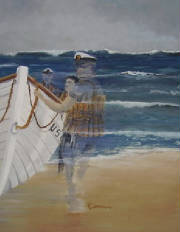Gallery Three -- Coast Guard Art

In the early morning hours of June 6, 1957 I was assigned as crewmember of Motor Lifeboat 36389. We were dispatched to assist the fishing vessel Anna L.A. located in the vicinity of Stemple Creek north of Point Reyes (CA). As we rounded the Point we were met head on by a full gale and our engine quit. Restarted, we continued on when the engine quit again for the final time. We were blown through the thunderous surf and beached her safely. There were no injuries thanks to the skill of the coxswain and our continuous training. The distress call that we were proceeding to was later determined to be a hoax...one that nearly cost the four of us our lives. This painting is IN a Private Collection.

Point Reyes Lifeboat Station was built in 1927 but the Coast Guards presence in the area dates back to 1888 when the first station was constructed. The area is described by official records as "the windiest and foggiest on the Pacific coast". The station is unique in that it consists a three marine railway system and housed two 36 foot motor lifeboats under cover of the boathouse. During its peak, the compliment consisted of 16 men commanded by a Chief Warrant Bosun. The station and all associated buildings were retired and transferred to the National Park Service in 1968 and is now part of the Point Reyes National Seashore.

The 255 foot CGC Klamath was on Alaskan patrol when on February 9th 1972 she was diverted to aid the flooding Japanese freighter Tenzan Maru. Fighting rough seas, snow and high winds, the Klamath rendezvoused with the stricken vessel on the following evening and immedately placed a repair party aboard. Unable to proceed north or east due to Tenzan Maru's weakend hull and weather conditions, the Klamath continued escorting her south arriving safely in San Francisco two weeks later. 34 lives were saved along with millions of dollars in property. This was painted shortly after the incident with the aid of radio reports.

Having started my CG career at a Lifeboat Station, I have somewhat of a soft spot in my heart for the men & women who today still carry out the rich traditions of the past. The U.S. Life-Saving Service was officially established in 1871 although its heritage can be traced to the 1700's. The Service was evenutally merged with the Revenue Cutter Service into the Coast Guard in 1915. Today, all prospective surfmen are subjected to months of rigorous training at the elite National Motor Lifeboat School at Cape Disappointment Washington at the mouth of the Columbia River.

This was completed on a very rough surface to see how the texture would react. The scene is fictitious but one that is familiar to many generations of Surfmen. Strangely, while painting this scene I felt very close to those involved and in reviewing my notes I found I had written "Still afloat but dangeriously close to broaching, the lone sailor is nearly safe after many horrifying days adrift. The end is near though for the frail little vessel as her jib begins to shred".

I have been asked from time to time what it takes to start a painting. Here I have put together some of my sketches of various subjects prior to starting the actual painting. Some are relatively detailed and others are not, like the quick sketch of the Point Winslow and Fort Point LBS at the bottom. Some are done with graphite (fancy for plain ole #2 pencil), acrylic, pen & ink. You have to start somewhere and this is it for me. Some paintings have required dozens of little thumbnails (sketches)to complete while others just one or two.






